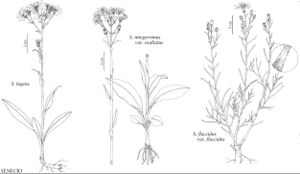Difference between revisions of "Senecio flaccidus var. flaccidus"
Illustrated
Synonyms: Senecio douglasii var. jamesii (Bentham) L. D. Benson Senecio douglasii var. longilobus Senecio longilobus
imported>Volume Importer |
imported>Volume Importer |
||
| Line 58: | Line 58: | ||
|publication year= | |publication year= | ||
|special status=Illustrated | |special status=Illustrated | ||
| − | |source xml=https:// | + | |source xml=https://bitbucket.org/aafc-mbb/fna-data-curation/src/2e0870ddd59836b60bcf96646a41e87ea5a5943a/coarse_grained_fna_xml/V19-20-21/V20_1239.xml |
|tribe=Asteraceae tribe Senecioneae | |tribe=Asteraceae tribe Senecioneae | ||
|genus=Senecio | |genus=Senecio | ||
Latest revision as of 19:59, 5 November 2020
Herbage usually tomentose (hairs whitish), sometimes unevenly glabrescent. calyculi: bractlets minute or 0. involucres cylindric or weakly campanulate. phyllaries ± 13 (± 21), 5– 8+ mm.
Phenology: Flowering mostly summer–fall, less frequently spring.
Habitat: Dry, open sandy or rocky plains, streambeds, and canyons
Elevation: 800–2400 m
Distribution

Ariz., Colo., Kans., N.Mex., Okla., Tex., Utah, Mexico.
Discussion
Senecio flaccidus var. flaccidus intergrades at least to some extent with var. monoensis in areas of overlapping ranges; a case could be made for treating the two as distinct species, as done by A. Cronquist (1994).
Selected References
None.
Lower Taxa
None.
